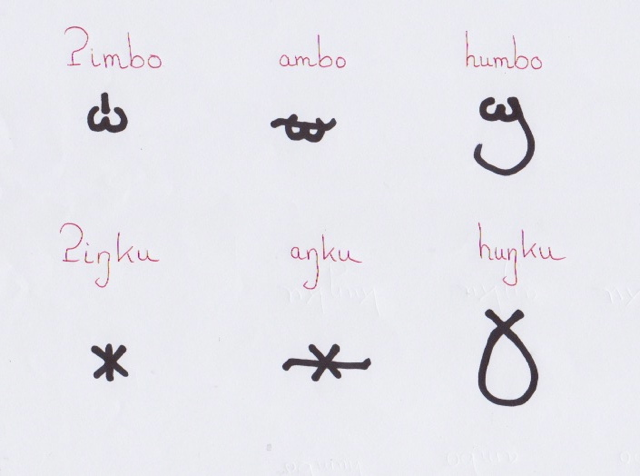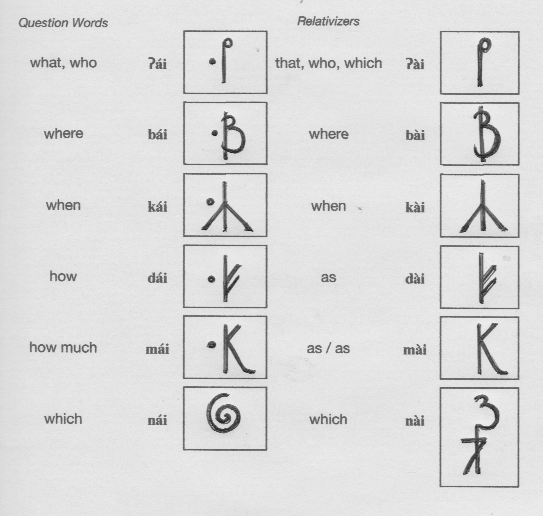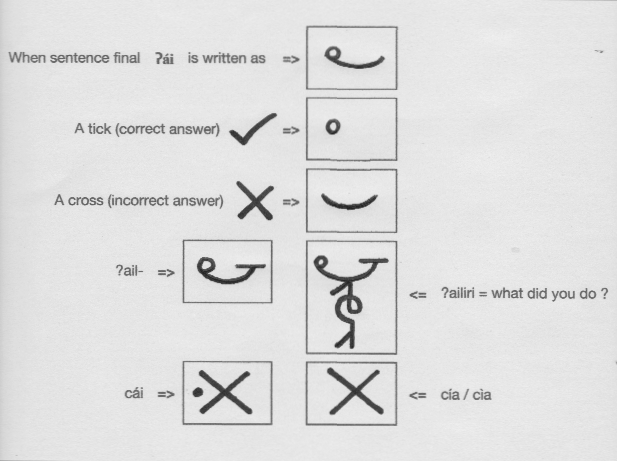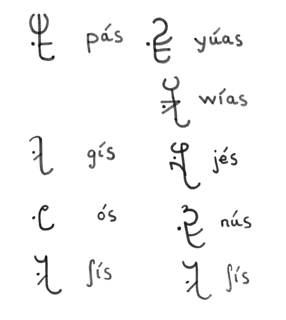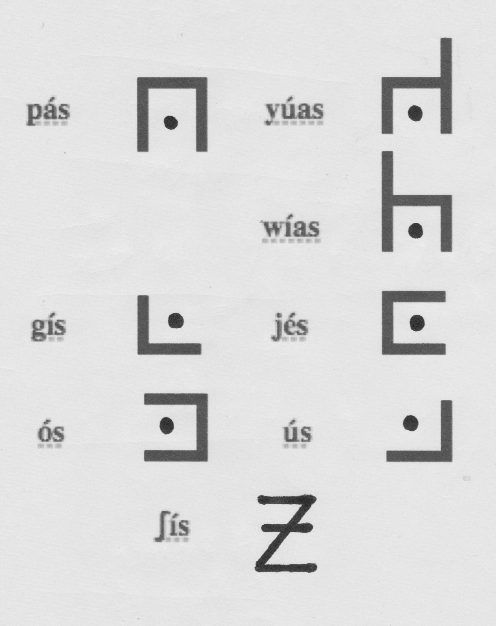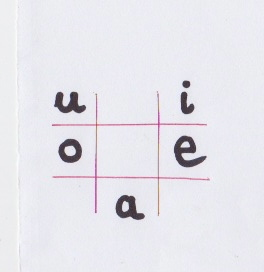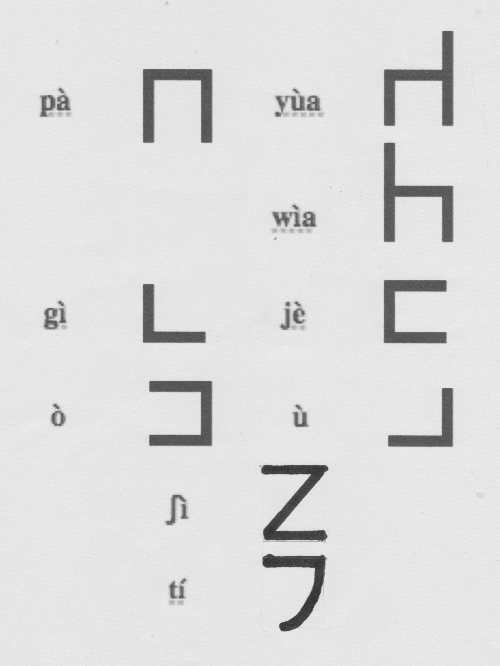Béu : Stuff discarded after 28th Mar 2013
..... Note .....
Stuff discarded before 28th Mar 2013 is in chapter XX
Stuff discarded after 28th Mar 2013 is in this chapter.
..... How to ask a content question
..
English is quite typical of languages in general and has 7 content question words ... "which", "what", "who", "where", "when", "how" and "why".
A corresponding set of béu question words are given below.
..
| what | nén nós |
| who | mín mís món |
| when | kyú |
| where | dwí |
| how | fáu |
| why | mái |
| how much | linai |
| how many | nonai |
| what type of | kainai |
..
In English as in about 1/3 of the languages of the world it is necessary to front the content question word.
In béu these words are usually also fronted. They must come before the verb anyway. If they come after the verb, they mean "somebody/something", "somewhere" etc. etc.
The pilana are added to the content question words as they would be to a normal noun phrase.
Here are some examples of content questions ...
Statement 1) báus glaye kyori alha = the man gave flowers to the woman
Question 2) mines glaye kyori alha = who gave flowers to the woman
Question 3) báus minye kyori alha = to whom did the man gave flowers
Question 4) báus glaye fái kyori = what did the man give to the woman
lí = amount
nò = number
5) báus ye fái gla ? kyori alha = to which woman did the man give the flowers
6) báus kyori ye á gla alha = the man gave flowers to some woman
7) báus kyori ye gla alha = the man gave flowers to a woman
..
ME-form of the verb and the MI-form of a verb
These tenses are often called the 'conditional', that is, they express a supposition depending on a certain condition. When referring to present time the ME-form is used ; when referring to past time and the condition has no chance of now being realised the MI-form is used.
if knowame to read buyame book => If I knew how to read I would buy a book.
if knowami to read buyami book => If I had known how to read I would have bought a book.
..... The 15 "specified"
‘I don’t know who/what/where/when/why/how etc.’, ‘who/what etc. you want/please’, ‘who/what etc. it may be’, and ‘it does not matter who/what etc.’. The following are usually called pronouns in the Western linguistic tradition.
In Old Norse, there is a rare free-choice indefinite pronoun velhverr ‘whosoever, everyone’, which consists of interrogative hverr plus a prefixed element vel-.
Old English has similar-looking indefinite forms in the series wel-hwá, wel- hwæt, (ge-)wel-hwær, (ge-)wel-hwilc ‘any/every-one, -thing, -where, any/every’, used as follows:
The fact that Swedish, Danish and Norwegian are historically related languages adds a further dimension to the contrastive perspective. The existential determiners någon (Swedish), nogen (Danish) and noen (Norwegian) clearly have a common origin in Old Norse, eventually going back to the unattested *ne wait ek hwariR, meaning ‘I don’t know which’.
Called the 15 specifyu in the béu linguistic tradition ????
| anything | ʔindai | "something" | andai | "somethings" | andaia | everything, all | hundai | every single thing | hunindai |
The above 5 words have a special "shorthand" form. These are given below.
| anybody | ʔín | somebody | án | some people | àn | all | hùn | every single person | hunin |
The above 5 words have special "shorthand" forms. These were given in the previous section.
| anywhere | ʔimbo | somewhere | ambo | everywhere | humbo |
| ever | ʔiŋku | sometime(s) | aŋku | always | huŋku |
The above 6 words have a special "shorthand" form. These are given below.
These words are obviously have their origins in a fusion of the "specifiers" and the three word below.
bwò = place
kyú = occasion
dái = thing
A word of warning about translating from béu to English ...
As the simple specifier, when they occur alone, always have human reference, you can not say something like ...
"Italian cars are very stylish but some are prone to rusting"
If you translated this directly to béu the "some" would mean "somebody", instead you have to say ...
"Italian cars are very stylish but some of them are prone to rusting"
"some of them" = àn ʃí
"Indian women are pretty but some get fat with time"
Here again, "some" can not be used alone and would be replaced by "some of them" = àn ù
And by the way "one of them" = án ʃí or án ú. Never * aja ʃí or * aja ú
Note that béu pronouns act the sane as nouns when it comes to "specifiers".
So in the same manner as you say "some house", you say "some us" or "some them" (i.e. not some of us, or some of them)
Note that béu does not have any words corresponding to "nobody", "nothing", "never" etc. etc. To translate a sentence from English which contained these words, you would use the ʔín equivalent and negate the main verb of the clause (as you can also do in English ... "I have never gone to London" => "I haven't ever gone to London")
hunde = ever
huninde = every single day
..... Question
béu has a "toolbox" that allows us to ask questions. The tools in that tool box are ʔái, bái, kái, dái, mái, nái and cái ... the seven words used for asking questions.
..... The ʔainandaua or the Question Words
The table below shows some of the béu ʔainandaua
| what, who | ʔái |
| where | bái |
| when | kái |
| how | dái |
| how much | mái |
"what/who" asks the interlocutor to give an argument for the clause given.
"where" asks the interlocutor to give a place for the clause given.
"when" asks the interlocutor to give a time for the clause given.
"how" asks the interlocutor to give an adverb for the clause given.
mái is slightly different ...
if placed in front of a noun, it asks the interlocutor to give a number if the noun is countable, if not countable it is asking for an amount.
if placed in front of an adjective, it asks the interlocutor to give the degree/level of the adjective (an amount ?? should we use the same grades for nouns and adjectives ??).
These words have to be fronted (as in English). That is they must come sentence initial.
ʔái takes pilana, just as a normal noun does. Here are some examples ...
Statement ... báus glaye kyori alha = the man gave flowers to the woman
Question 1) ʔáis glaye kyori alha = who gave flowers to the woman
Question 2) ʔaiye báus kyori alhai = to whom did the man gave flowers
Question 3) ʔái báus glaye kyori = what did the man give to the woman
Notice that in 1, ʔáis is interpreted as "who" because it is overwhelmingly the case that a person would be giving flowers to somebody.
Similarly for 2, and in 3, ʔái is interpreted as "what" because it is overwhelmingly the case that a person would be giving an nonhuman object to somebody else.
By the way "why" is translated as ʔaiji "for what".
In English it is not wrong to say "what man gave the woman flowers" rather than "which man gave the woman flowers".
In béu "what" can never be conjoined with a noun as is possible in English.
In English it is not TOTALLY wrong to say "which gave the woman flowers" rather than "which man gave the woman flowers".
In béu "which" must always be conjoined with a suitable noun or pronoun.
The word for "which" is nái and it always comes after the noun that it is conjoined with. No fronting is required for nái.
For example ....
Question 4) báus nái glaye kyori alha= which man gave flowers to the woman
Question 5) báus yè glà nái kyori alha= to which woman did the man gave flowers
Question 6) báus glaye kyori alha nái= which flowers did the man give to the woman
Notice that in 5, nái and the word that it is conjoined with, can not be seperated by the pilana ye.
"which one" would be translated as ʃì nái if we are referring to a non-A argument and non-human.
"which ones" would be translated as nò ʃì nái if we are referring to a non-A argument and non-human.
"which one" would be translated as ò nái if we are referring to a non-A argument but human.
"which ones" would be translated as ù nái if we are referring to a non-A argument but human.
Of course to refer to an A argument, we simple add -s to the pronoun.
..... How to ask a yes/no question
To turn a normal statement into a polar question (i.e. a question that requires a YES/NO answer), we stick the particle ʔái on the end of the sentence.
ʔái is neutral as to the response you are expecting. If you are expecting a positive reply, you would use the particle ʔaiwa instead.
To answer a positive question, YES or NO ( ʔaiwa àu aiya ) is sufficient.
To answer a negative question positively, YES ( ʔaiwa ) is enough.
To answer a negative question negatively, you must give an entire clause.
For example ;-
Statement 1) glà (rà) hauʔe = The woman is beautiful.
Question 1) glà hauʔe ʔái = Is the woman beautiful ? .......... If she is beautiful, answer ʔaiwa, if she isn't answer aiya.
Statement 2) glà (ká) hauʔe = The woman isn't beautiful.
Question 2) glà ká hauʔe ʔái = Isn't the woman beautiful ? ........ If she isn't beautiful, answer ʔaiwa, if she is answer ò rà hauʔe. (notice that the copula must be used in this case)
( in a later section we will see that it is not always necessary to use ʔái. When you have a clause with a modal, you simply change the word order to ask a polar question. ) ???
Also it is possible to focus on a particular element when asking a YES/NO question in béu. This is done by putting the particle cái after the element that you want to focus on. For example ...
Statement 1) báus glaye timpi alhai = the man gave flowers to the woman
Straight question 2) báus glaye timpi alha ʔái = did the man gave flowers to the woman ?
Focused question 3) báus glaye cái timpi alha = Is it the woman that the man gave flowers to ?
Actually there is a way to focused elements in a statement which mirrors the way to focus elements in a question. We use either cía or cìa for this.
Focused statement 4) báus glaye cía timpi alhai = It is the woman to whom the man gave the flowers.
The particle has a high tone if following a neutral tone word or a low tone word. If it focuses a high tone word it has a low tone i.e. cìa.
..... The other ʔainandaua
As well as the five question words given above, béu also has a question verb (ʔail-) meaning "to do what". For example ...
ʔailiri = "what will you do"
ʔailora jonos jene = "what is John doing to Jane"
It doesn't have to be fronted but it usually is.
..... The relativizers
The table below shows the béu relativizers.
| that, who, which | ʔài |
| where | bài |
| when | kài |
| as, in the manner that | dài |
| as | mài |
"that,who,which" gives the interlocutor the argument which is not stated in the clause following "that,who,which".
"where" gives the interlocutor the place which is not stated in the clause following "where".
"when" gives the interlocutor the time which is not stated in the clause following "when".
"how" gives the interlocutor the manner which is not stated in the clause following "how".
mài is slightly different ...
if placed after a noun, it gives the interlocutor the amount or number for that noun by means of the NP following mài.
twor ble? pàn mài (twor) gìn = I have as much money as you.
if placed after an adjective, it gives the interlocutor to the degree/level of that adjective by means of the NP following mài.
wáu òn (rà) nela mài wáu pàn = His eyes are as blue as my eyes.
I THINK THAT THIS IS OK. IS IT ??
One way in which the first three (ʔài, bài and kài) can be analysed, is to say that they are nominalizers, they turn a clause into a noun. Then you could say that a relative clause is simply a nominal that stands in apposition to the noun which it qualifies.
Now all these words found in the question toolbox are very common. Because of this, they have a shorthand way of being written. These are given below ...
..... The "whatever" constuction
ʔinʔa = "whatever"
There are 3 ʔinʔanandau ... ʔinʔa, ʔinʔai and ʔinʔau (meaning whatever, wherever and whenever)
ʔinʔaza = the "whatever" construction
béu has a similar construction to the English "whatever" construction.
?? Maybe we should consider it built up from a diachronic process.
1) solboi ʔá dori sawoi = Those drinks that she/he made are delicious
2) ʔín solboi ʔá dori sawoi = Any drink that she made is delicious
3) ʔín ʔá dori sawoi = Any that she made is delicious (solboi being understood from context)
4) ʔinʔa dori sawoi = Whatever she made is delicious (with the noun NOT being known from the context, unless it is that most generic of all nouns ... "thing"). See the section " ..... Question Words" for an interesting parallel to what is appearing here.
We can see that 4) could well have occurred diachronically from 3). ???
Now we have a new word ʔinʔa. If this is thought of as a word similar to the determiners or the quantifiers/specifiers which can either appear by themselves or with a noun, then it is not so strange to start getting constructions such as 5) occurring.
5) ʔinʔa solboi dori sawoi = Whatever drinks she made are delicious
ʔá dori is not allowed clause initially .... however dè ʔá dori or ʔinʔa dori sawoi is allowed.
however = ʔím we??
..... Pronouns
In this section we discuss pronouns and also introduce the S, A and O arguments.
béu is what is called an ergative language. About a quarter of the world languages are ergative or partly ergative. So let us explain what ergative means. Well in English we have 2 forms of the first person singular pronoun ... namely "I" and "me". Also we have 2 forms of the third person singular male pronoun ... namely "he" and "him". These two forms help determine who does what to whom. For example "I hit him" and "He hit me" have obviously different meanings (in English there is a fixed word order, which also helps. In béu the word order is free).
timpa = to hit ... timpa is a verb that takes two nouns (LINGUISTIC JARGON ... a transitive verb).
pás ò timpari = I hit him pà ós timpori = He hit me ... OK in this case the protagonist marking in the verb also helps to make things disambiguous. But this will not always help, for example when both protagonists are third person and of the same number.
So far so good. And we see that English and béu behave in the same way so far. But what happens when we take a verb that takes only one noun (LINGUISTIC JARGON ... a transitive verb). For example doika = "to walk". In English we have "he walked". However in béu we don't have *ós doikori but ò doikori (equivalent to saying "*him walked" in English). So this in a nutshell is what an ergative language is.
It is the convention to call the doer in a intransitive clause the S argument. For example òS fomporta = She has tripped
It is the convention to call the "doer" in a transitive clause the A argument and the "done to" the O argument For example ósA timpori jeneO = He hit Jane
The S was historically from the word "Subject" and the O historically from the word "Object", but it is best just to forget about that. In fact when I use the word "subject" I am talking about either the S argument or the A argument.
If you like you can say ;-
In English "him" is the "done to"(O argument) : "he" is the "doer"(S argument) and the "doer to"(A argument).
In béu ò is the "done to"(O argument) and the "doer"(S argument) : ós is the "doer to"(A argument).
Below the form of the béu pronouns is the given for when the pronoun is the A argument.
| I | pás | we (includes "you") | yúas |
| we (doesn't include "you") | wías | ||
| you | gís | you (plural) | jés |
| he, she | ós | they | ús |
| it | ʃís | they | ʃís |
However these pronouns are never written out as above. There is a recognized "shorthand" method of writing them. This is shown below.
This method is based on the fact that all the pronouns have a different vowel sound (the ones that refer to humans anyway). A look at a béu vowel chart might let you work out what is happening here.
In fact these pronouns are usually dropped when possible, so it might be better to translate the above as "I myself", "you yourself" etc. etc.
Below the form of the béu pronouns is the given for when the pronoun is the S or O argument. When they are used as S arguments it might be better to translate these pronouns as "I myself", "you yourself" etc. etc.
| me | pà | us | yùa |
| us | wìa | ||
| you | gì | you (plural) | jè |
| him, her | ò | them | ù |
| it | ʃì | them | ʃì |
The above table is for S and O arguments, it fact we have another pronoun but this one only occurs as an O argument. When a action is performed by somebody on themselves we use tí to represent the O argument.
Just as in English, we do not say "*I hit me", but "I hit myself" ... in béu we do not say *pás pà timpari, but pás tí timpari.
The table above shows the shorthand form for these non-ergative pronouns.
tí does not have to immediately* follow the ergative pronoun but it usually does. There is a recognised way to write the ergative pronoun plus the reflexive particle (i.e. we have one symbol to represent two words). These are shown below.
LINGUISTIC JARGON ... "myself" is what is called a "reflexive pronoun". In English there are many reflexive pronouns (i.e. "myself", "yourself", "herself", etc. etc.) : in béu only one.
Pronouns can just be set down beside each other if they both make up the same argument in a clause. Unlike normal nouns which must have é ( "and" ) between them and any other component.
*It is a rule that tí must follow the A argument.
The possessive form of these pronouns
| my | pàn | our | yùan |
| our | wìan | ||
| your | gìn | your (plural) | jèn |
| his, her | òn | their | ùn |
| its | ʃìn | their | ʃìn |
And we also have tín which is used if the possessor is the same as the subject of the clause.
Index
- Introduction to Béu
- Béu : Chapter 1 : The Sounds
- Béu : Chapter 2 : The Noun
- Béu : Chapter 3 : The Verb
- Béu : Chapter 4 : Adjective
- Béu : Chapter 5 : Questions
- Béu : Chapter 6 : Derivations
- Béu : Chapter 7 : Way of Life 1
- Béu : Chapter 8 : Way of life 2
- Béu : Chapter 9 : Word Building
- Béu : Chapter 10 : Gerund Phrase
- Béu : Discarded Stuff
- A statistical explanation for the counter-factual/past-tense conflation in conditional sentences

